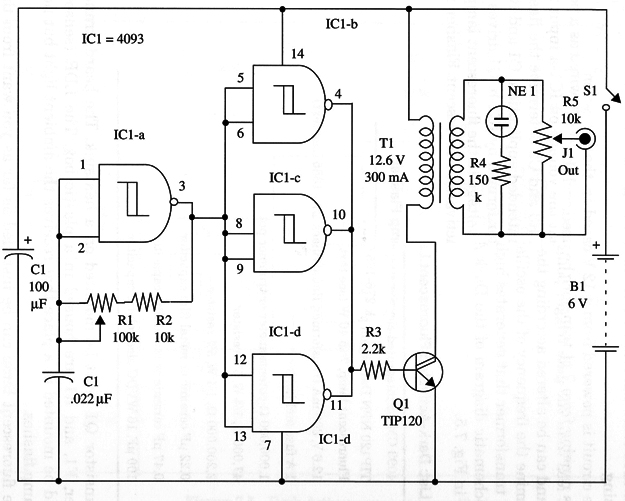This device can be used in controlled biological experiments. The circuit will produce high voltages (up to 300 V) at low current rates to stimulate nerves in several kind of tests.
The intensity of stimulus is adjusted by R5, and frequency is adjusted by R1. The circuit is powered from D cells (NiCad or alkaline) or a 6 V rechargeable battery. Current drain is about 100 mA.
The neon lamp is used to indicate circuit operation.
The electrodes depend on the experiments. Two metal tubes with diameters ranging from 1/2 to 1 inch can be used for manual stimulation.
A schematic diagram of the Nerve Stimulator is shown in Fig. 1.

Any small transformer with the primary rated to 117 Vac and the secondary with voltages ranging from 6 V to 12.6 V and currents between 100 mA and 500 mA can be experimented. Best results are obtained by adjusting R1.
Transistor Q1 must be mounted on a heatsink. Any neon lamp can be used to indicate the Circuit’s operation. The output is a common enclosed jack (mono) and a phono plug connects the electrodes.
To use, first adjust R5 to a minimum and close Sl to power up the circuit. After this, adjust R1 and R5 for the desired stimulus.
IC1 - 4093 CMOS integrated circuit
Q1 - TIP120 NPN Darlington power transistor
NE-1 - Common neon lamp, NE-2H or equivalent
T1 - 12.6, 300 mA transformer, primary 117 Vac
R1 - 10,000 Ω potentiometer
R2 - 10,000 Ω, 1/4 W, 5% resistor
R3 - 2,200 Ω, 1/4 W, 5% resistor
R4 - 150,000 Ω, 1/4 W, 5% resistor
R5 - 10,000 Ω - potentiometer
C1 - 100 µF, 16 WVDC electrolytic capacitor
C2 - 0.022 µF ceramic or metal film capacitor
J1 Output jack



